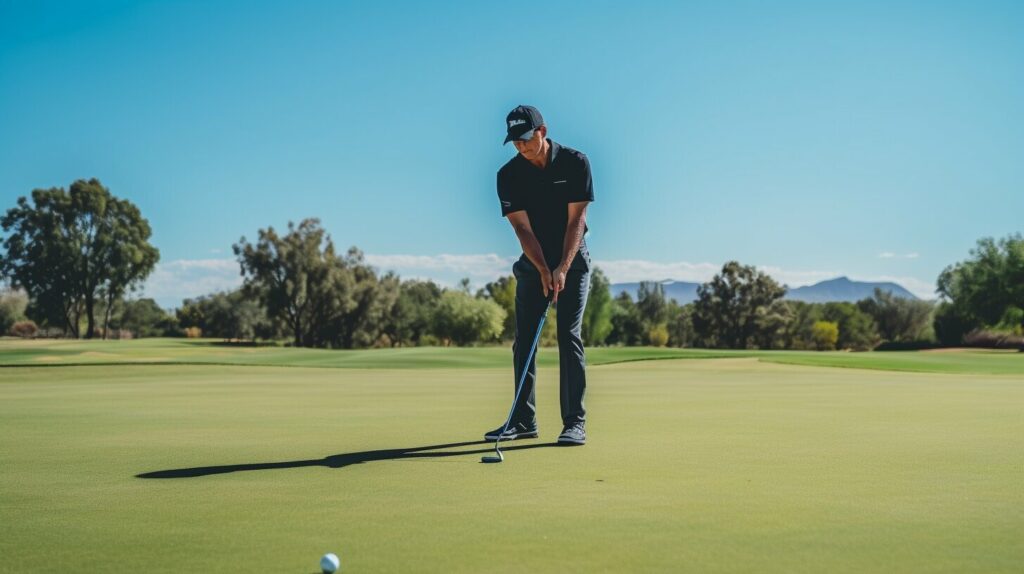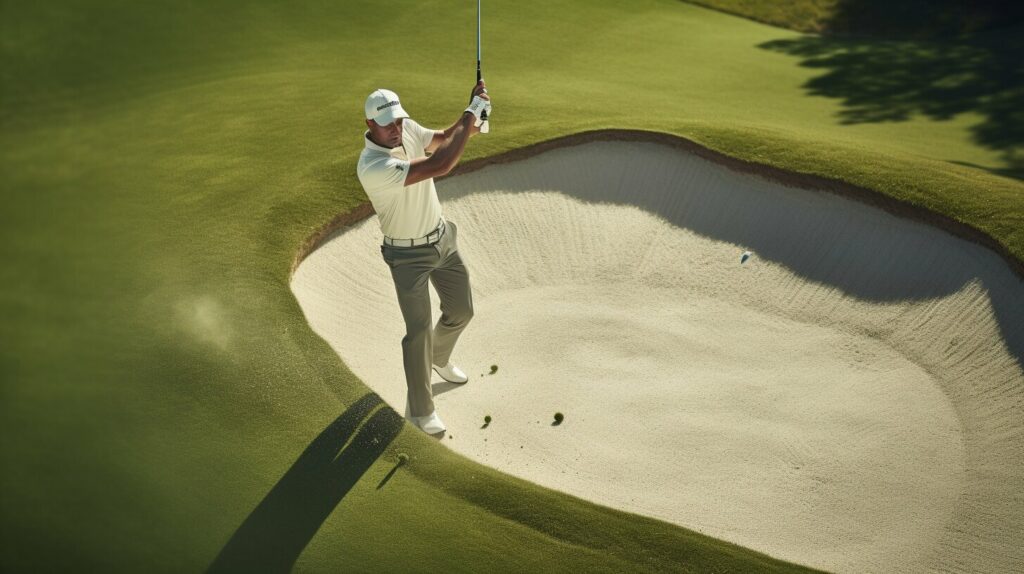Golf is a game of skill, strategy, and patience. An essential part of a golfer’s skill set is chipping – the ability to take short, controlled shots around the green. Mastering the art of chipping can mean the difference between a good round and a great one. Whether you’re a beginner or an experienced golfer, improving your chipping game is essential for lowering your score and enhancing your overall golfing experience.
How to Chip in Golf
In this comprehensive guide, we will explore the fundamentals of chipping, as well as techniques, strategies, and tips to help you become a better chipper. We’ll cover everything from club selection, swing tempo, and body rotation to advanced techniques like high spin chips and bump and run shots. Additionally, we’ll delve into chipping drills, practice routines, and troubleshooting common mistakes to help you hone your skills and achieve greater consistency.
Understanding the Basics of Chipping
Chipping is a crucial shot in golf that can make or break a golfer’s round. To execute an effective chip, it’s essential to have a solid foundation in the basics. Here’s what you need to know:
| Club Selection | Grip | Stance |
|---|---|---|
| Club Selection: Choose a club that will allow you to hit the ball high with minimal roll. Generally, an iron or wedge with a high loft is recommended. | Grip: Grip the club with your left hand in a neutral position and your right hand in a slightly weakened position. This will help you maintain control and feel during the shot. | Stance: Position your feet shoulder-width apart and align them parallel to the target line. Distribute your weight evenly on both feet with slightly more weight towards your front foot. |
These basics will provide a solid foundation for your chipping technique. But before moving on to advanced techniques, it’s crucial to master these fundamentals.
Additional Tips:
- Keep your hands ahead of the ball throughout the shot to encourage a descending strike.
- Use a narrow stance for increased stability and control.
- Maintain a light grip pressure to promote a smooth and fluid swing.

Remember, chipping is as much a mental game as it is a physical one. Stay focused on your technique, and most importantly, trust yourself and your abilities.
Perfecting Your Chipping Technique: Swing Slowly
One of the most crucial aspects of chipping is controlling the swing tempo. Many golfers make the mistake of swinging too fast or too hard, leading to inconsistent shots. To perfect your chipping technique, it is essential to swing slowly with smooth acceleration.
Swinging slowly allows you to have better control of the club and achieve accuracy in your shots. A slower swing also helps you to hit the ball cleanly, enabling you to make solid contact and get the ball up and down quickly.
When executing a chip shot, focus on the rhythm and tempo of your swing. Take the club back slowly and smoothly, then accelerate gradually as you make contact with the ball. Keep your eyes on the ball and maintain a stable stance throughout the swing to avoid any unnecessary movements.
Remember, chipping is all about finesse and touch, not power. By swinging slowly and smoothly, you can achieve better results and enhance your overall chipping proficiency.

Mastering the Art of Chipping: Expert Tips and Techniques
How to Chip Better: Using the Right Club
Choosing the right club for chipping is critical in achieving better results on the course. The choice of club depends on the distance to the hole and the lie of the ball. Using the wrong club can lead to mishits, poor trajectory, and loss of control, resulting in poor shots and higher scores.
The most common clubs used for chipping are wedges, including the pitching wedge, sand wedge, and lob wedge. Pitching wedges are usually the go-to club for shorter chips, while sand wedges are suitable for bunker shots and thicker lies. Lob wedges are ideal for high/soft shots over obstacles and onto elevated greens.

When selecting a club, it’s important to consider the loft angle, bounce angle, and shaft length. Higher lofted clubs produce a higher trajectory, while lower lofted clubs produce a lower trajectory. The bounce angle refers to the angle between the leading edge and the trailing edge of the clubhead. More bounce means the club will glide over the surface more easily, while less bounce allows for cleaner contact with the ball. Finally, choose a club with a length that you are comfortable with and suits your playing style, whether it’s a shorter or longer shaft.
It’s also crucial to take into account the type of shot you want to execute. For example, for a bump and run shot, use a lower lofted club, while for a high spin shot, use a higher lofted club. It’s also essential to consider the lie of the ball, as thicker lies require more loft to get the ball up in the air.
By selecting the right club based on distance, lie, and shot type, golfers can improve their chipping performance and reduce their scores on the course.
Techniques for Enhanced Chipping Accuracy
As we have discussed, chipping is a crucial aspect of a golfer’s game. Being able to hit accurate and consistent chip shots can make all the difference in lowering your score. Here are some techniques that can help improve your chipping accuracy:
- Proper Body Rotation: When chipping, it’s important to rotate your body towards the target to ensure a consistent swing. Keep your weight forward and your hands ahead of the ball to promote a downward strike. This will help you achieve more control over your shots and produce a clean contact with the ball.
- Weight Transfer: To hit accurate chip shots, you need to transfer your weight smoothly from your back foot to your front foot. This will help you maintain a consistent rhythm and tempo throughout the swing, leading to better accuracy and distance control.
- Hand Position: Your hand position during the swing is crucial for chipping accuracy. Keep your hands soft and relaxed, and avoid using too much wrist action. For better control, place your hands slightly ahead of the ball at address and maintain this position throughout the swing.
- Visualization: Before hitting your chip shot, visualize the trajectory and landing spot of the ball. This will help you stay focused and confident while executing the shot, leading to better accuracy and consistency.
By incorporating these techniques into your chipping game, you can achieve enhanced accuracy and control on the course.

Developing Consistency in Chipping
Chipping requires consistency to achieve better control, accuracy and distance. Consistency also enhances muscle memory and provides a reliable chipping stroke. Here are some tips to develop consistency in chipping:
1. Practice regularly
The more you practice chipping, the better you become at it. Consistent practice develops muscle memory that helps you hit better chip shots on the course. It is vital to practice chipping from different lies, distances and green conditions that you might encounter on the course.
2. Maintain consistent rhythm and tempo
One of the essential elements of a successful chipping stroke is maintaining a consistent rhythm and tempo. To accomplish this, ensure that your backswing and downswing have the same tempo, and your follow-through is smooth and controlled.

3. Use the same technique every time
Consistency comes from practicing the same technique repeatedly. Once you find a technique that works for you, stick to it, and practice it consistently. Using the same technique helps you develop confidence and a feel for the shot.
4. Keep it simple
When working on developing consistency, focus on keeping your technique simple. Avoid trying to accomplish too many things at once. Instead, concentrate on making a good stroke, and let muscle memory do the rest.
By consistently practicing and maintaining a steady rhythm and tempo, using the same technique, and keeping it simple, golfers can develop a reliable chipping stroke and improve their overall performance.
Chipping Strategies for Different Lies
Chipping on the golf course can present various challenges, particularly when facing different lies. Properly assessing each lie and adopting the appropriate chipping strategies can significantly improve your chances of making accurate and consistent chip shots. Here are some tips for chipping from various lies:
Uphill Lies
When facing an uphill lie, position the ball in the center or slightly forward in your stance and aim to take a steeper angle of attack. Use a higher lofted club, such as a sand wedge or lob wedge, to prevent the ball from rolling back down the slope. Take a smooth, controlled swing, and follow through to achieve a high trajectory.
Downhill Lies
When chipping from a downhill lie, position the ball towards your back foot and keep your weight on your front foot to ensure a descending strike. Use a less lofted club, such as an 8 or 9 iron, and take a shorter backswing to help control the shot. Follow through to achieve a low trajectory with spin to prevent the ball from rolling too far past the hole.
Sidehill Lies
Chipping from a sidehill lie can be challenging because the slope can affect the ball’s direction and trajectory. To compensate for this, position the ball according to the slope, with the higher side facing the target. Use a club with enough loft to get the ball in the air, and take a longer backswing and follow through to keep the clubface square at impact.

Remember to practice chipping from different lies to develop the necessary skills and gain confidence. With the right chipping strategies and techniques, you can master the art of chipping in golf and significantly improve your overall game.
Mastering Short Distance Chipping
Chipping from short distances is essential to scoring well in golf. It requires precision and control to execute a shot that lands softly on the green and rolls towards the hole. Here are some tips on how to improve your short distance chipping:
1. Use a Wedge with High Loft
When chipping from a short distance, it’s best to use a wedge with a high loft. This type of club will help you get the ball up in the air quickly and land softly on the green. Aim to use a wedge with at least 56 degrees of loft.
2. Focus on Your Stance and Setup
When setting up for a short distance chip, make sure your feet are close together and your weight is evenly distributed. Position the ball towards the back of your stance and lean your weight slightly towards your lead foot. This setup will help you make solid contact with the ball and create enough spin to stop the ball quickly on the green.
3. Keep Your Hands Ahead of the Ball
Another crucial aspect of short distance chipping is keeping your hands ahead of the ball at impact. This position ensures that you hit down on the ball and create the necessary loft for the shot. It also helps to keep the clubface square and avoid any unwanted side spin.
4. Practice Under Pressure
Short distance chipping is a shot that you’ll need to make often during a round of golf. Therefore, it’s important to practice this shot regularly under pressure. Create a variety of short shots around the green and challenge yourself to get up and down as many times as possible. This practice will help you build confidence in your short game and make you a better chipper.

5. Develop a Consistent Swing
Creating a consistent swing is crucial to becoming a better short distance chipper. Focus on keeping your tempo smooth and your swing length consistent. Avoid decelerating through impact and keep your follow-through short and compact. These adjustments will help you create the right amount of spin for the shot and land the ball softly on the green.
6. Experiment with Different Shots
To become a versatile and skilled chipper, it’s essential to experiment with different shot types. Try different trajectories, spin rates, and landing angles to get a feel for what works best in different situations. This experimentation will help you develop a wider range of shots and make you a better short distance chipper.
Advanced Chipping Techniques
For experienced golfers who want to take their chipping to the next level, there are several advanced techniques to consider. These shots require precision and skill, but they can be highly effective in certain situations.
Flop Shot
The flop shot is a high, soft shot that is designed to clear an obstacle such as a bunker or a tree and land softly on the green. To execute a flop shot, open the face of your highest lofted wedge, take a wider stance, and position the ball toward your front foot. Make a steep swing with your wrists, and follow through high to create more loft and height on the ball.
Bump and Run
Also known as the chip and run, the bump and run is a low, rolling shot that is used when you need to get the ball on the green and rolling as soon as possible. To execute a bump and run, use a club with less loft, position the ball toward your back foot, and make a putting stroke with a straight wrist. The ball should land near the fringe of the green and roll out to the hole.

High Spin Chip
The high spin chip is a shot that creates a lot of backspin on the ball, causing it to stop quickly on the green. To execute a high spin chip, use a wedge with a high degree of loft, position the ball toward your back foot, and make a sharp descending blow on the ball. To create more spin, make sure your wrists are fully released at impact.
Remember, these shots require practice and precision to master. Use them wisely and you can elevate your chipping game to new heights.
Troubleshooting Common Chipping Mistakes
Chipping can be a difficult and frustrating aspect of golf, even for experienced players. However, by identifying and correcting common mistakes, golfers can improve their chipping performance. Here are some tips for troubleshooting common chipping mistakes:
Thin Shots
One of the most common mistakes in chipping is hitting the ball thin, resulting in a low trajectory and little control. To avoid thin shots, focus on striking the ball with a descending blow. Ensure that your weight is on your front foot at impact and that your hands are ahead of the ball. This will help you hit down on the ball, producing a clean and accurate shot.
Fat Shots
Hitting the ground before the ball is another frequent error in chipping. This is known as a “fat shot” and can result in the ball traveling only a short distance with little control. To avoid fat shots, focus on keeping your weight forward and your hands ahead of the ball throughout the swing. Avoid trying to scoop the ball with your club, and instead focus on hitting down on the ball with a steady, descending motion.
Inconsistent Distance Control
Another common mistake in chipping is inconsistent distance control. This can be caused by a variety of factors, including lack of practice, improper club selection, and poor technique. To improve distance control, practice regularly and focus on developing a consistent swing tempo and rhythm. Additionally, pay attention to the trajectory of your shots and adjust your club selection accordingly. Finally, focus on maintaining a stable and balanced stance throughout the swing and follow-through.

Conclusion
By addressing common chipping mistakes, golfers can improve their chipping performance and overall game. Remember to focus on proper technique, club selection, and distance control, and practice regularly to achieve consistent results. With these tips, you can become a more confident and successful golfer.
Mental Approach to Chipping
Chipping is not just a technical skill; it is also a mental game. To truly master chipping, golfers must have the right mindset and mental approach.
Stay Calm: It is common for golfers to feel anxious or nervous while chipping, especially when faced with difficult shots. However, it is essential to stay calm and composed. Taking deep breaths and mentally visualizing a successful shot can help ease nerves and anxiety.
Focus: Focus is critical in chipping as even a slight distraction can lead to a poor shot. Concentrate on the shot at hand and avoid letting external factors like the crowd, weather, or other golfers affect your focus.
Confidence: Confidence is key to successful chipping. Believe in your abilities and trust in the training and practice you have put in. Positive self-talk and visualization can help build confidence and ensure a more focused and successful shot.
Manage Pressure: Chipping can often be a high-pressure situation, especially in tournaments or crucial moments of a round. It is crucial to manage pressure and not let it affect your game. Setting realistic expectations, focusing on the process rather than the outcome, and not getting too emotionally invested in the result can all help manage pressure effectively.
By adopting the right mental approach to chipping, golfers can enhance their overall performance and achieve greater success in their game.

Chipping Drills and Practice Routines
To develop consistency in chipping, it is crucial to practice regularly and efficiently. Below are some drills and practice routines that can significantly improve your chipping skills:
Drill 1: Target Practice
Set up a target on the green, such as a tee or a coin. Position yourself at different distances and aim to land your chips as close to the target as possible. Focus on controlling distance and trajectory with different clubs. This drill helps improve accuracy and confidence in chipping.
Drill 2: Uphill and Downhill Lies
Practice chipping from uphill and downhill lies on the course or create artificial slopes on the practice green. Experiment with different club selection, hand position, and swing tempo to adapt to the lie and control the ball’s roll-out. This drill helps develop versatility in chipping.
Drill 3: Short Game Poker
Play a game with your friends or practice partners where each player starts with an equal number of chips. Each chip is worth a designated distance from the hole. Each time a player chips the ball within the designated distance, they earn a chip. The player with the most chips at the end of the game wins. This drill helps improve pressure management and performance in chipping.

Practice Routine: Repetitive Chipping
Select a target on the green and practice chipping to the same target repeatedly with different clubs and chipping techniques for at least 10-15 minutes. This routine helps build muscle memory and rhythm in chipping.
Practice Routine: Random Distances
Set up multiple targets on the green at different distances and randomly chip to each target with different clubs and chipping techniques. This routine helps simulate real-game situations and improve versatility in chipping.
Incorporate these drills and practice routines into your chipping practice to take your game to the next level. Remember to focus on the fundamentals, stay committed to regular practice, and keep a positive mindset.
Tips for Chipping on Different Green Conditions
Chipping on different green conditions can be a challenge for even the most seasoned golfers. Factors such as green speed, slope, and grass type can greatly affect the outcome of a chip shot. Here are some tips to help you improve your chipping game on different green conditions:
Chipping on Fast Greens
When chipping on fast greens, it’s important to keep in mind that the ball will roll much farther than it would on slower greens. To compensate for this, use a lower lofted club and a shorter backswing to reduce the amount of spin and loft on the ball. This will help keep the ball low and rolling towards the hole.
Also, pay close attention to the slope of the green. If the green slopes towards the hole, aim your shot to the low side to take advantage of the slope and let the ball roll towards the hole.
Chipping on Slow Greens
On slow greens, you can use a higher lofted club and a longer backswing to help get the ball in the air and over any obstacles. Take note of any bumps or mounds on the green and adjust your aim accordingly.
Since the ball will not roll as much on slower greens, it is important to focus on distance control. Take a careful look at the distance to the hole and aim to land the ball just in front of the hole, allowing it to roll the rest of the way.
Chipping on Undulating Greens
Undulating greens can be challenging for chipping, but with the right technique and strategy, you can still be successful. Take note of the direction and degree of the slope on the green and aim your shot accordingly.
Use a lower lofted club and a shorter backswing if you need to keep the ball low and rolling, and a higher lofted club and longer backswing if you need to get the ball in the air and over obstacles.
It’s also important to focus on your weight distribution during your swing. When chipping on undulating greens, shift your weight towards your front foot during your backswing, and then shift it towards your back foot during your downswing to help control the trajectory and direction of the shot.

By following these tips and adjusting your chipping technique for different green conditions, you can improve your accuracy, distance control, and overall performance on the golf course.
FAQ – Frequently Asked Questions about Chipping in Golf
Q: What is chipping in golf?
A: Chipping in golf involves hitting a shot that is intended to fly a short distance and then roll towards the hole on the green. This shot is usually executed with a wedge or a short iron club.
Q: Why is chipping important in golf?
A: Chipping is an essential skill in golf that can significantly impact a player’s overall performance. Proper chipping technique can help golfers save strokes by getting the ball closer to the hole and avoiding high scores on the scorecard.
Q: What is the best club for chipping?
A: The best club for chipping depends on various factors, such as the distance from the hole, the lie of the ball, and the green conditions. Generally, a wedge or a short iron club, such as a pitching wedge or a sand wedge, is most suitable for chipping.
Q: How do I improve my chipping accuracy?
A: Improving chipping accuracy requires practice and proper technique. Focus on maintaining a consistent tempo and rhythm in your swing, keep your hands in the correct position, and develop a reliable chipping stroke through regular, deliberate practice.
Q: How do I avoid thin shots when chipping?
A: To avoid thin shots, ensure proper weight transfer during the swing, keep your hands ahead of the clubhead, and maintain a consistent tempo. Also, focus on striking the ball with a descending blow and taking a shallow divot after impact.
Q: What should I do if I consistently hit fat shots when chipping?
A: Consistently hitting fat shots can be caused by various factors, such as incorrect weight transfer, improper setup, or poor club selection. Practice chipping with different clubs and focus on maintaining your balance and a smooth swing rhythm to avoid hitting the ground before making contact with the ball.
Q: How do I manage the pressure of chipping on the course?
A: To manage pressure while chipping, practice visualization techniques, focus on your breathing and posture, and stay calm and confident. Trust in your technique and avoid overthinking your shots on the course.
Q: What are some advanced chipping techniques?
A: Advanced chipping techniques include specialty shots like flop shots, bump and run shots, and high spin chips. These shots require precise execution and control. Practice them on the practice range before attempting to use them on the course.
Q: How do I adjust my chipping technique for different green conditions?
A: Different green conditions require different chipping techniques. On fast greens, focus on using less loft and keep the ball low to the ground, while on slow greens, use more loft and a higher trajectory for better stopping power. On undulating surfaces, adjust your aim and read the contours of the green to optimize your chip shot.